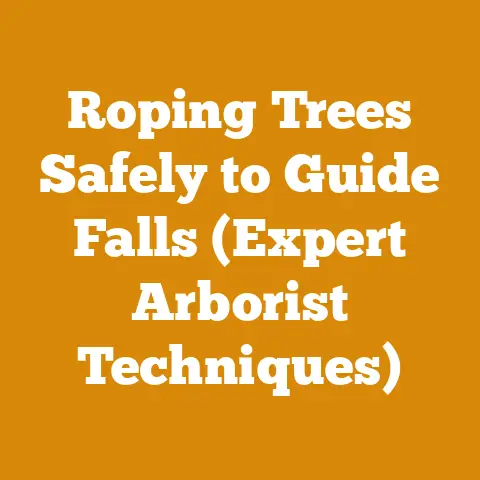Can Carpenter Ants Destroy Trees? (5 Expert Woodwork Insights)
As someone deeply involved in sustainable forestry, I always advocate for eco-friendly approaches in wood processing.
It’s crucial to consider the environmental impact of our actions, whether it’s selecting sustainably harvested wood or using eco-friendly treatments.
Now, let’s dive into the main topic.
Can Carpenter Ants Destroy Trees? (5 Expert Woodwork Insights)
Carpenter ants.
Just the name can send shivers down the spine of any homeowner or woodworker.
We all know they can wreak havoc on wooden structures, but what about trees?
Can these industrious insects actually destroy living trees?
As someone who’s spent years felling trees, processing wood, and dealing with the aftermath of infestations, I’ve got some insights to share.
Let’s explore the truth about carpenter ants and their impact on trees, drawing from my experiences and expertise.
Understanding Carpenter Ants
Before we get into the nitty-gritty, let’s clarify what carpenter ants are.
They are large ants known for excavating wood to create nests.
Unlike termites, they don’t eat the wood; they simply tunnel through it.
This tunneling can weaken wooden structures, and yes, it can affect trees as well.
Carpenter ants are not all created equal.
There are many species, and their behavior can vary.
In my region, the most common culprits are black carpenter ants, but identifying the specific species is crucial for effective control.
Insight 1: The Role of Decay
Here’s the key: Carpenter ants primarily target wood that is already decaying or damaged.
They prefer wood that is softened by moisture, rot, or fungal decay.
I’ve seen countless trees in the forest that are riddled with carpenter ant nests, but upon closer inspection, they almost always have some underlying issue.
Think of it this way: a healthy tree has natural defenses.
Its bark protects it, and its sap can deter insects.
But when a tree is weakened, it becomes vulnerable.
A broken branch, a fungal infection, or even just old age can make it an inviting target for carpenter ants.
My experience in logging has taught me that identifying signs of decay is crucial.
Discoloration, soft spots, and unusual growths are all red flags.
These are the areas where carpenter ants are most likely to move in.
Insight 2: Carpenter Ants as Secondary Invaders
This brings us to the next point: Carpenter ants are often secondary invaders.
They don’t typically attack healthy, sound wood.
Instead, they move in after another problem has already weakened the tree.
For example, I once worked on a project where we had to remove a large oak tree that was infested with carpenter ants.
Initially, it seemed like the ants were the main problem.
However, upon closer examination, we discovered that the tree had a severe fungal infection at its base.
The fungus had softened the wood, making it easy for the ants to excavate their nests.
In this case, the carpenter ants were not the primary cause of the tree’s decline.
They were simply taking advantage of an existing problem.
This is a common scenario, and it’s important to understand the difference.
Insight 3: Signs of Carpenter Ant Infestation in Trees
So, how can you tell if a tree is infested with carpenter ants?
Here are some key signs to look for, based on my observations in the field:
- Sawdust (Frass): Carpenter ants don’t eat wood, so they create sawdust as they tunnel.
You might find small piles of this sawdust near the base of the tree or around entry points.
The sawdust is usually a mix of wood particles and insect droppings. - Visible Entry Points: Look for small holes or slits in the bark.
These are the entry points where carpenter ants are accessing the wood.
They often prefer to enter through existing cracks or wounds. - Noises: On a quiet evening, you might be able to hear the ants moving around inside the tree.
It sounds like a faint rustling or clicking noise.
I’ve used a stethoscope to amplify these sounds in some cases. - Ant Activity: Of course, seeing carpenter ants around the tree is a strong indicator.
Pay attention to where they are going and coming from.
Are they entering through a specific hole?
Are they carrying sawdust? - Weakened Branches: If the infestation is severe, it can weaken branches, making them more likely to break.
Look for dead or dying branches, especially if they are concentrated in one area of the tree.
Remember, these signs don’t necessarily mean that the tree is doomed.
Early detection and intervention can often save the tree.
Insight 4: The Impact on Tree Health and Stability
While carpenter ants don’t usually kill healthy trees outright, their tunneling can have a significant impact on tree health and stability.
The extent of the damage depends on several factors, including the size of the infestation, the species of ant, and the overall health of the tree.
Here’s how carpenter ants can affect trees:
- Weakening the Structure: The tunnels created by carpenter ants can weaken the tree’s structural integrity, making it more susceptible to wind damage and breakage.
This is especially true for large trees with heavy canopies. - Creating Entry Points for Disease: The holes created by the ants can also serve as entry points for fungi and bacteria, which can further weaken the tree and lead to disease.
- Reducing Nutrient Flow: In severe cases, the tunneling can disrupt the flow of water and nutrients within the tree, leading to stunted growth and decline.
- Attracting Other Pests: A carpenter ant infestation can also attract other pests, such as termites and wood-boring beetles, which can compound the problem.
I’ve seen trees that have been so weakened by carpenter ants that they pose a serious safety hazard.
In these cases, removal is often the only option.
Insight 5: Prevention and Control Strategies
So, what can you do to protect your trees from carpenter ants?
Here are some prevention and control strategies that I’ve found to be effective:
- Maintain Tree Health: The best defense against carpenter ants is a healthy tree.
Make sure your trees are properly watered, fertilized, and pruned.
Remove any dead or dying branches promptly. - Address Decay and Damage: If you notice any signs of decay or damage, address them immediately.
This might involve removing infected wood, applying a fungicide, or repairing damaged bark. - Seal Entry Points: If you find carpenter ant entry points, seal them with caulk or wood filler.
This will prevent the ants from accessing the wood. - Use Insecticides Carefully: Insecticides can be effective for controlling carpenter ant infestations, but they should be used carefully and according to the label instructions.
I recommend consulting with a professional pest control company before using insecticides on trees. - Consider Natural Remedies: Some people have success with natural remedies, such as diatomaceous earth or borax.
These can be applied around the base of the tree or injected into entry points. - Monitor Regularly: The key to preventing serious damage is to monitor your trees regularly for signs of infestation.
The earlier you catch a problem, the easier it will be to control.
Remember, prevention is always better than cure.
By taking good care of your trees and addressing any problems promptly, you can minimize the risk of carpenter ant infestations.
Detailed Explanation of Wood Decay and Why Carpenter Ants Prefer It
I mentioned earlier that carpenter ants primarily target wood that is already decaying or damaged.
Let’s delve deeper into why this is the case.
Wood decay is a natural process that occurs when fungi break down the cellulose and lignin in wood.
This process softens the wood, making it easier for carpenter ants to excavate their nests.
There are several types of wood decay, including:
- Brown Rot: This type of decay is caused by fungi that break down the cellulose in wood, leaving behind a brown, crumbly residue.
Brown rot is common in softwoods, such as pine and fir. - White Rot: This type of decay is caused by fungi that break down both the cellulose and lignin in wood, leaving behind a bleached, whitish appearance.
White rot is common in hardwoods, such as oak and maple. - Soft Rot: This type of decay is caused by fungi that can break down wood even in very wet or dry conditions.
Soft rot is common in wood that is in contact with soil or water.
The type of decay present in a tree can influence the type of carpenter ant that infests it.
Some species of carpenter ants prefer wood that is affected by brown rot, while others prefer wood that is affected by white rot.
From my experience, I’ve observed that trees with extensive decay are often heavily infested with carpenter ants.
The ants create large, interconnected nests within the decayed wood, which can further weaken the tree.
Case Study: Carpenter Ant Infestation in a Mature Maple Tree
Let me share a case study from my own experience.
A few years ago, I was called to assess a mature maple tree in a residential neighborhood.
The homeowner was concerned because she had noticed a large number of carpenter ants around the base of the tree.
Upon inspection, I found several signs of carpenter ant infestation, including:
- Piles of sawdust near the base of the tree
- Visible entry points in the bark
- Ant activity around the tree
I also noticed that the tree had a large cavity at its base, which was filled with decayed wood.
The decay was likely caused by a combination of fungal infection and insect damage.
I used a probe to assess the extent of the decay.
The probe easily penetrated the decayed wood, indicating that it was significantly softened.
I also found evidence of carpenter ant nests within the decayed wood.
Based on my assessment, I concluded that the tree was heavily infested with carpenter ants and that the decay had significantly weakened its structural integrity.
I recommended that the tree be removed to prevent it from falling and causing damage or injury.
The homeowner followed my recommendation, and the tree was safely removed.
Upon further inspection, we found that the tree was even more extensively decayed than we had initially thought.
The carpenter ants had created a vast network of tunnels within the decayed wood, which had severely weakened the tree.
If the homeowner had noticed the problem earlier, it might have been possible to save the tree.
Detailed Look at Prevention Strategies
Now, let’s get into the nitty-gritty of prevention strategies.
As I mentioned before, maintaining tree health is paramount.
Proper Watering:
- Young Trees: Water deeply once or twice a week during the first year after planting.
This encourages deep root growth.
Use a soaker hose or drip irrigation to deliver water directly to the root zone. - Mature Trees: Mature trees are generally more drought-tolerant, but they can still benefit from supplemental watering during prolonged dry spells.
Water deeply and infrequently, allowing the soil to dry out between waterings. - Watering Depth: Aim for a watering depth of at least 12 inches.
You can use a soil probe to check the depth of moisture. - Avoid Overwatering: Overwatering can lead to root rot, which can weaken the tree and make it more susceptible to carpenter ant infestation.
Fertilization:
- Soil Testing: Before fertilizing, it’s a good idea to have your soil tested to determine its nutrient content.
This will help you choose the right fertilizer for your trees. - Fertilizer Type: Use a slow-release fertilizer that is specifically formulated for trees.
These fertilizers release nutrients gradually over time, providing a steady supply of nourishment. - Application Rate: Follow the instructions on the fertilizer label carefully. Over-fertilizing can damage trees.
- Application Timing: The best time to fertilize trees is in the spring or fall.
Avoid fertilizing during the heat of summer.
Pruning:
- Remove Dead or Dying Branches: Dead or dying branches are a breeding ground for decay fungi, which can attract carpenter ants.
Remove these branches promptly. - Prune for Air Circulation: Prune trees to improve air circulation.
This will help to reduce the risk of fungal infections. - Proper Pruning Techniques: Use proper pruning techniques to avoid damaging the tree.
Make clean cuts at a 45-degree angle, just above a bud or branch. - Hire a Professional: If you’re not comfortable pruning trees yourself, hire a professional arborist.
Addressing Decay and Damage:
- Remove Infected Wood: If you find any decayed wood, remove it completely.
Cut back to healthy wood, and dispose of the infected material properly. - Apply Fungicide: If the decay is caused by a fungal infection, apply a fungicide to the affected area.
Choose a fungicide that is specifically formulated for trees. - Repair Damaged Bark: If the bark is damaged, repair it as soon as possible.
Use a tree wound dressing to protect the exposed wood from infection.
These detailed prevention strategies, combined with regular monitoring, can significantly reduce the risk of carpenter ant infestations in your trees.
Safety Precautions When Dealing with Infested Trees
Working with trees, especially those infested with carpenter ants, requires strict adherence to safety protocols.
I’ve seen firsthand the consequences of neglecting safety, and it’s not something I take lightly.
Personal Protective Equipment (PPE):
- Hard Hat: Always wear a hard hat to protect your head from falling branches or debris.
- Safety Glasses: Wear safety glasses to protect your eyes from sawdust and other particles.
- Gloves: Wear gloves to protect your hands from splinters and cuts.
- Hearing Protection: If you’re using power tools, wear hearing protection to prevent hearing loss.
- Long Sleeves and Pants: Wear long sleeves and pants to protect your skin from scratches and insect bites.
- Steel-Toed Boots: Wear steel-toed boots to protect your feet from falling objects.
Tool Safety:
- Chainsaws: If you’re using a chainsaw, make sure you’re properly trained and certified.
Always wear appropriate PPE, including a chainsaw helmet with face shield and hearing protection, chainsaw chaps, and gloves.
Inspect the chainsaw before each use, and follow the manufacturer’s instructions carefully. - Ladders: If you’re using a ladder, make sure it’s stable and properly positioned.
Never overreach or stand on the top rung. - Power Tools: Use power tools only for their intended purpose, and follow the manufacturer’s instructions carefully.
Always wear appropriate PPE.
Environmental Awareness:
- Be Aware of Your Surroundings: Be aware of your surroundings, and watch out for hazards such as power lines, traffic, and pedestrians.
- Work in a Safe Area: Work in a safe area, away from obstacles and hazards.
- Communicate with Others: If you’re working with others, communicate clearly and coordinate your activities.
Dealing with Carpenter Ants:
- Avoid Direct Contact: Avoid direct contact with carpenter ants.
They can bite, and some people are allergic to their venom. - Use Insecticides Carefully: If you’re using insecticides, follow the label instructions carefully.
Wear appropriate PPE, and avoid spraying near water sources or food crops. - Dispose of Infested Wood Properly: Dispose of infested wood properly.
Do not burn it, as this can release harmful chemicals into the air.
Instead, take it to a landfill or other designated disposal site.
Emergency Preparedness:
- Have a First-Aid Kit: Have a well-stocked first-aid kit on hand, and know how to use it.
- Know Emergency Contact Numbers: Know the emergency contact numbers for your area.
- Have a Communication Plan: Have a communication plan in place in case of an emergency.
By following these safety precautions, you can minimize the risk of accidents and injuries when working with trees infested with carpenter ants.
Sustainable Wood Processing and Eco-Friendly Treatments
As I mentioned in the introduction, I’m a strong advocate for sustainable wood processing and eco-friendly treatments.
When dealing with trees infested with carpenter ants, it’s important to consider the environmental impact of your actions.
Sustainable Harvesting:
- Selectively Harvest Trees: Selectively harvest trees that are infested with carpenter ants, leaving healthy trees standing.
This will help to maintain the health and diversity of the forest. - Use Sustainable Logging Practices: Use sustainable logging practices, such as reduced-impact logging, to minimize the impact on the environment.
- Replant Trees: Replant trees after harvesting to ensure the long-term health of the forest.
Eco-Friendly Treatments:
- Borax: Borax is a natural mineral that is effective for killing carpenter ants.
It can be applied as a dust or dissolved in water and sprayed on infested areas. - Diatomaceous Earth: Diatomaceous earth is a natural powder made from fossilized algae.
It is effective for killing carpenter ants by dehydrating them. - Essential Oils: Some essential oils, such as peppermint oil and tea tree oil, are effective for repelling carpenter ants.
- Avoid Chemical Insecticides: Avoid using chemical insecticides whenever possible.
These insecticides can be harmful to the environment and to human health.
Responsible Disposal:
- Recycle Wood: Recycle wood whenever possible.
This will help to reduce the amount of waste that goes to landfills. - Compost Wood: Compost wood that is not suitable for recycling.
This will help to enrich the soil and reduce the need for chemical fertilizers. - Dispose of Wood Properly: Dispose of wood properly.
Do not burn it, as this can release harmful chemicals into the air.
Instead, take it to a landfill or other designated disposal site.
By using sustainable wood processing and eco-friendly treatments, you can minimize the environmental impact of dealing with trees infested with carpenter ants.
Actionable Metrics for Success
To measure the success of your prevention and control efforts, here are some actionable metrics you can track:
- Number of Infested Trees: Track the number of trees on your property that are infested with carpenter ants.
A decrease in this number indicates that your efforts are working. - Size of Infestations: Monitor the size of carpenter ant infestations.
Smaller infestations are easier to control. - Tree Health: Assess the overall health of your trees.
Look for signs of decay, damage, and stress.
Healthy trees are less susceptible to carpenter ant infestations. - Insecticide Use: Track the amount of insecticide you use.
A decrease in insecticide use indicates that you are relying more on prevention strategies. - Wood Waste: Monitor the amount of wood waste you generate.
A decrease in wood waste indicates that you are using sustainable wood processing practices. - Cost of Treatment: Track the cost of treating carpenter ant infestations.
A decrease in the cost of treatment indicates that your prevention efforts are paying off.
By tracking these metrics, you can gain valuable insights into the effectiveness of your prevention and control efforts.
This will help you to make informed decisions and optimize your strategies for long-term success.
Common Mistakes to Avoid
Over the years, I’ve seen people make a lot of mistakes when dealing with carpenter ants and trees.
Here are some common pitfalls to avoid:
- Ignoring the Problem: The biggest mistake is to ignore the problem.
Carpenter ant infestations can worsen quickly, so it’s important to take action as soon as you notice signs of infestation. - Misidentifying the Pest: It’s important to correctly identify the pest.
Carpenter ants are often confused with termites, but the treatment strategies are different. - Treating the Symptoms, Not the Cause: Don’t just focus on killing the ants.
Address the underlying cause of the infestation, such as decay or damage. - Using Insecticides Indiscriminately: Avoid using insecticides indiscriminately.
Use them only when necessary, and follow the label instructions carefully. - Neglecting Prevention: Prevention is key.
Don’t neglect the preventive measures I’ve outlined in this guide. - DIY Treatments Without Knowledge: Attempting DIY treatments without proper knowledge can be ineffective and even harmful.
Consult with a professional if you’re unsure what to do. - Ignoring Safety Precautions: Always follow safety precautions when working with trees and power tools.
By avoiding these common mistakes, you can increase your chances of successfully preventing and controlling carpenter ant infestations in your trees.
Final Thoughts
Carpenter ants can indeed damage trees, but they are usually secondary invaders, targeting wood that is already decaying or damaged.
By understanding their behavior, recognizing the signs of infestation, and implementing effective prevention and control strategies, you can protect your trees and maintain a healthy landscape.
Remember to prioritize sustainable practices and safety in all your wood processing endeavors.






